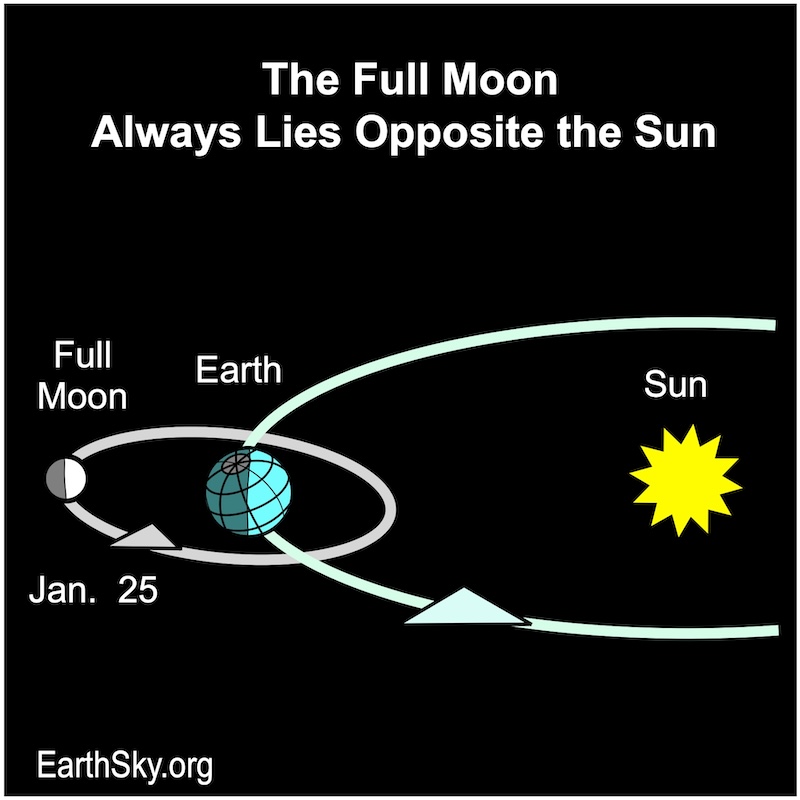
When and where to look in 2024: Look for the bright, round, full moon to rise in the east near sunset on January 25, 2024. It’ll be glowing nearly overhead around midnight, and dropping low in the west near sunrise.
Crest of the full moon falls at 17:54 UTC on January 25. That’s 11:54 a.m. CST.
January’s full moon is the Wolf Moon
All full moons have popular nicknames. January’s full moon is often called the Wolf Moon because – in parts of the world where they live – wolves are active in January and often howl on cold nights. Other names derived from North American indigenous people also refer to January’s cold. They include the Cold Moon, Frost Exploding Moon, Freeze Up Moon, and Hard Moon.
2024 lunar calendars on sale now. Makes a great gift! Check it out here.
January full moon path
At full moon, the sun, Earth, and the moon align in space, with Earth in the middle. As a result, the moon’s day side – its fully lighted hemisphere – directly faces us. That is why the moon appears full. Also – as seen from the Northern Hemisphere – the sun travels daily in a short, low arc across the January sky. On the other hand, the full moon, opposite the sun in the sky, travels in a long, high arc across the sky, and passes nearly overhead around local midnight. Meanwhile, as seen from the Southern Hemisphere, the January sun is high, and the moon is low.

January’s full moon in front of Cancer
The January full moon can lie in front of one of two constellations of the zodiac. If the full moon falls in the first half of the month, as it did last year, it lands in Gemini the Twins. If it happens during the second half, as it does this year, it falls in Cancer the Crab.
The moon is roundest on the day when it is full, but it appears almost, but not quite full the day before and after. On the evening of this January’s full moon, the twin stars of Gemini, Castor (the dimmer one) and Pollux (the brighter one) shine nearby. However, the bright moonlight may make these two famous stars dim or even invisible. If you can’t spot them, rest assured, they are still there!
The full moon glows next to the Beehive
The pretty, but dim Beehive star cluster twinkles immediately below the full moon. It is much dimmer than Castor and Pollux, and it will be much closer to the bright moon making it indiscernible. So, to see the Beehive properly, you’ll need to come back when a bright moon isn’t in the sky.

January full moon and the July sun
Every full moon stays – more or less – opposite the sun. The moon’s path roughly follows the sun’s daytime path from six months ago, and six months from now.
In the Northern Hemisphere, you can see this happening as you watch the January full moon rise to almost the top of the sky, just as the sun does in July.
For the Southern Hemisphere, it’s the same effect, but reversed. Since it’s early summer there, the full moon in January rides low in the sky as the January sun rides high.
Tracing the high path of the January full moon
You can experiment with the path of the sun and moon. Simply trace a line with your finger from east to west along a low arc above the southern horizon to emulate the sun’s January path. Then trace another path high overhead to emulate the moon’s path in January. You’ll see that the higher path will be much longer than the lower one.
The monthly paths come into balance
Little by little, we can watch the two paths come back into balance. Each month, the full moon will cross the sky at a slightly lower arc than the previous month. Each successive full moon takes less time than the previous one to cross the sky. Since last month’s full moon was closest to the winter solstice, it rose the highest. At March’s full moon, which is near the Northern Hemisphere’s spring equinox, the two paths – of the moon and of the sun – will nearly be the same.
Then, near the June solstice, those of us in the Northern Hemisphere see the sun cross high overhead during the year’s longest days. And, during the short northern summer nights, we see the moon cross lower and spend less time in the sky.
And on the cycle goes.

Bottom line: The 2024 January full moon falls on January 25 at 17:54 UTC (11:54 a.m. CST). It’s in Cancer and appears nearby the Beehive star cluster. It also closely follows the path of the sun in July.











